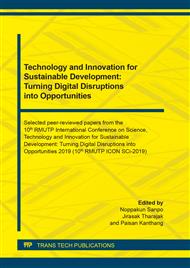p.3
p.11
p.17
p.23
p.31
p.37
p.43
p.49
Effect of Photosynthetic Microorganism on Lime Plant Growing and Fruiting
Abstract:
Lime plant has an absolute requirement of nutrients for growing. The microbial application can facilitate in addressing limited access to chemical fertilizer concern. Moreover, the photosynthetic microorganism community can contribute together in nutrient availability for plant growing and fruiting. The objectives of this research were analyzed the growth rate of photosynthetic microorganism in a fermented juice within three months. A fermented juice was analyzed in terms of MLSS, COD, and nutrient. The efficiencies of fermented juice of lime plant growing, and fruiting was also investigated. The lime plant growth rate was collected in terms of plant height, and fruiting. The experimental results showed that the concentration of microbes in a fermented juice was maintained approximately 1,063 ± 135 mg/L on average (n=5). The photosynthetic microorganism concentration and nutrients concentration in fermented juice was a significant promotion of productivity of lime plant growing and fruiting.
Info:
Periodical:
Pages:
23-27
Citation:
Online since:
August 2020
Authors:
Keywords:
Price:
Сopyright:
© 2020 Trans Tech Publications Ltd. All Rights Reserved
Share:
Citation:


